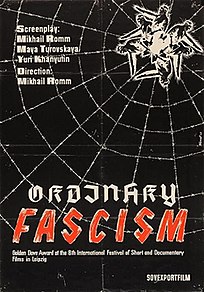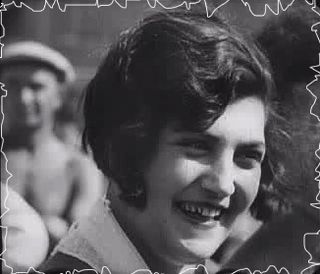
Sergei Mikhailovich Eisenstein was a Soviet film director and film theorist, a pioneer in the theory and practice of montage. He is noted in particular for his silent films Strike (1925), Battleship Potemkin (1925) and October (1928), as well as the historical epics Alexander Nevsky (1938) and Ivan the Terrible. In its decennial poll, the magazine Sight & Sound named his Battleship Potemkin the 11th greatest movie of all time.

Newsreel footage of the 6 May 1937 Hindenburg disaster, where the zeppelin LZ 129 Hindenburg crashed and burned down, was filmed by several companies.
Movietone News is a newsreel that ran from 1928 to 1963 in the United States. Under the name British Movietone News, it also ran in the United Kingdom from 1929 to 1979.

Cannibal Holocaust is a 1980 Italian cannibal horror film directed by Ruggero Deodato and written by Gianfranco Clerici. It stars Robert Kerman as Harold Monroe, an anthropologist from New York University who leads a rescue team into the Amazon rainforest to locate a crew of filmmakers. Played by Carl Gabriel Yorke, Francesca Ciardi, Perry Pirkanen, and Luca Barbareschi, the crew had gone missing while filming a documentary on local cannibal tribes. When the rescue team is only able to recover the crew's lost cans of film, an American television station wishes to broadcast the footage as a sensationalized television special. Upon viewing the reels, Monroe is appalled by the team's actions and objects to the station's intent to air the documentary.
The actuality film is a non-fiction film genre that, like the documentary film, uses footage of real events, places, and things, yet unlike the documentary is not structured into a larger argument, picture of the phenomenon or coherent whole. In practice, actuality films preceded the emergence of the documentary. During the era of early cinema, actualities—usually lasting no more than a minute or two and usually assembled together into a program by an exhibitor—were just as popular and prominent as their fictional counterparts. The line between "fact" and "fiction" was not so sharply drawn in early cinema as it would become after the documentary came to serve as the predominant non-fiction filmmaking form. An actuality film is not like a newspaper article so much as it is like the still photograph that is published along with the article, with the major difference being that it moves. Apart from the traveling actuality genre, actuality is one film genre that remains strongly related to still photography.

All Our Yesterdays was a television series, produced by Granada Television, giving an historical account of the 1930s lead-up to the Second World War and to the war itself. It relied on black-and-white film footage, and may be considered a precursor to the later Thames Television World at War production. Only 47 episodes of the original series (1960-1973) survive whereas the later series (1987-89) survives complete.

Lennon Legend: The Very Best of John Lennon was released on DVD in November 2003 as a series of remastered, remixed, and new videos with Dolby Digital 5.1 Surround Sound audio mixes.
Helen van Dongen was a pioneering editor of documentary films who was active from about 1925–1950. She collaborated with filmmaker Joris Ivens from 1925 to 1940, made several independent documentaries, and edited two of Robert Flaherty's films before retiring from filmmaking in her 40s.

Triumph Over Violence (Russian: Obyknovennyy fashizm, Обыкновенный фашизм — ″Common fascism″) is a 1965 Soviet film directed by Mikhail Romm. The film is also known as Echo of the Jackboot in the United Kingdom and Triumph Over Violence in the United States. It is mainly in the form of annotated excerpts of archival film in order to describe the rise and fall of fascism, and especially the example of Nazi Germany.

A Sixth Part of the World, sometimes referred to as The Sixth Part of the World, is a 1926 silent film directed by Dziga Vertov and produced by Kultkino. Through the travelogue format, it depicted the multitude of Soviet peoples in remote areas of USSR and detailed the entirety of the wealth of the Soviet land. Focusing on cultural and economic diversity, the film is in fact a call for unification in order to build a "complete socialist society". A mix between newsreel and found footage, Vertov edited sequences filmed by eight teams of kinoks (kinoki) during their trips. According to Vertov, the film anticipates the coming of sound films by using a constant "word-radio-theme" in the intertitles. Thanks to A Sixth Part of the World and his following feature The Eleventh Year (1928), Vertov matures his style in which he will excel in his most famous film Man with a Movie Camera (1929).
Collage film is a style of film created by juxtaposing found footage from disparate sources. The term has also been applied to the physical collaging of materials onto film stock.
German Concentration Camps Factual Survey is the official British documentary film on the Nazi concentration camps, based on footage shot by the Allied forces in 1945.

Night Will Fall is a 2014 documentary film directed by Andre Singer that chronicles the making of the 1945 British government documentary German Concentration Camps Factual Survey. The 1945 documentary, which showed gruesome scenes from newly liberated Nazi concentration camps, languished in British archives for nearly seven decades and was only recently completed.

The War for Men's Minds is a 21-minute 1943 Canadian documentary film, made by the National Film Board of Canada (NFB) as part of the wartime The World in Action series. The film was produced by Stuart Legg. The War for Men's Minds describes the impact of propaganda from the Axis powers in 1943, during the Second World War. The French version title of The War for Men's Minds is À la conquête de l'esprit humain.
Lest We Forget (1935) was the first feature-length documentary film with sound to be made in Canada. Written, directed and edited by Frank Badgley, who was then the Director of the Canadian Government Motion Picture Bureau, and W.W. Murray, with music by Edmund Sanborn and narrated by Rupert Caplan. A compilation, 10-reel film recounting Canada’s role in the First World War, it is fast-paced and has a verbose narration but was well received by critics and audiences at the time. The Bureau was the precursor to the National Film Board of Canada.
Kino-Eye is a film technique developed in Soviet Russia by Dziga Vertov. It was also the name of the movement and group that was defined by this technique. Kino-Eye was Vertov's means of capturing what he believed to be "inaccessible to the human eye"; that is, Kino-Eye films would not attempt to imitate how the human eye saw things. Rather, by assembling film fragments and editing them together in a form of montage, Kino-Eye hoped to activate a new type of perception by creating "a new filmic, i.e., media shaped, reality and a message or an illusion of a message - a semantic field." Distinct from narrative entertainment cinema forms or otherwise "acted" films, Kino-Eye sought to capture "life unawares" and edit it together in such a way that it would form a new, previously unseen truth.












